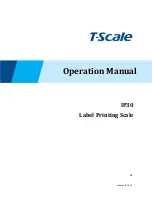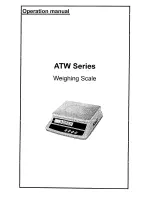
Service Information
7
4.0
Service Information
4.1
Troubleshooting Guide
System does not operate—no display
•
Power disconnected: Check and reconnect.
•
Indicator fuse blown. Replace fuse. Check for
cause.
•
Interface cable cut or disconnected: Repair.
•
Signal leads incorrectly installed at indicator:
Install according to indicator installation manual
Display stays at zero
•
Indicator faulty: Service indicator
•
Load cell connections faulty: Check cable
connections in summing board and at indicator
Erratic weights
•
Vibration near scale: Remove source of
vibration or move scale.
•
Platform not level to within
1
/
4
in: Level
scale by adjusting feet or shimming if
necessary.
•
Load cell or cable water damage: Replace.
•
Debris under load cells or platform: Clean.
•
Indicator faulty: Use simulator to test
indicator for stability. Service indicator.
Consistently high or low weights
•
Indicator not properly adjusted to zero: Zero
the indicator according to indicator manual.
•
Platform binding: Obtain adequate clearance
for free platform movement.
•
Indicator not calibrated: Calibrate according
to indicator manual and Section 3.3
•
Load cells faulty: Test and replace load cells
if necessary.
•
Feet touching deck underside: Adjust feet
downward to provide clearance.
4.2
Periodic Maintenance
The space beneath the platform must be periodically
cleaned to prevent debris buildup.
Caution
Do not attempt to use scales with load
cells that are not hermetically sealed in
washdown applications. Water damage
i s a c o m m o n c a u s e o f f a i l u r e i n
non-hermetically-sealed load cells. Use care with high
pressure steam washdowns for hermetically-sealed
load cells. The steam may not damage the load cells,
but the elevated temperatures may cause incorrect
readings until the unit cools to room temperature.
4.3
Load Cell Replacement
Replacement load cells can be ordered from Rice
Lake Weighing Systems according to the part
numbers in Table 4-2 on page 8. Refer to Table 1-1 on
page 1 for torque settings.
1. Remove defective load cells.
2. Disconnect load cell cable from summing
board and cut cable ties.
1
4
2
3
Figure 4-1. Load Cell Arrangement
3. When the cable is freed, pull cable out of the
scale.
4. Lay out each load cell near the corner where it
is to be installed.
5. Attach the cable from each load cell along the
frame and into the summing board as shown
in Figure 4-1.
NOTE:
In Figure 4-1, both the scale and the summing board
are viewed from the top. To verify correct load cell/summing
board terminal matching, see the numbers on the terminals
inside the summing board
.
6. Check that the threaded holes for the load cell
screws are free of debris. Use compressed air
to blow out holes if necessary.
Содержание Benchmark LP
Страница 1: ...104742 Benchmark LP Low Profile Bench Scale Installation Manual TM ...
Страница 2: ......
Страница 4: ...ii Benchmark LP Manual ...































